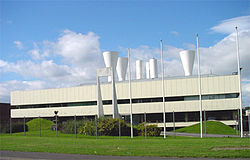Engineering Research Centre in Killingworth, Tyne & Wear
| Gas Council Engineering Research Station | |
|---|---|
| ERS | |
 | |
 | |
| Former names | Gas and Engineering Research Station |
| Alternative names | British Gas Engineering Research Station |
| General information | |
| Type | Engineering Research Centre |
| Address | Killingworth, Tyne & Wear, NE12 0SB |
| Coordinates | 55°02′10″N 1°34′48″W / 55.036°N 1.58°W / 55.036; -1.58 |
| Elevation | 60 m (197 ft) |
| Current tenants | North Tyneside Planning Dept |
| Construction started | 1966 |
| Completed | 1967 |
| Inaugurated | 1967 |
| Client | Gas Council |
| Owner | British Gas, Northern Gas Board |
| Technical details | |
| Structural system | Pre-cast reinforced concrete |
| Floor count | 3 |
| Floor area | 50,000 sq ft |
| Design and construction | |
| Architect(s) | Peter Yates |
| Architecture firm | Ryder & Yates & Partners |
The Gas Council Engineering Research Station (ERS) was a former engineering research institute on Tyneside, situated in a distinctively-shaped and listed building, now occupied by the Metropolitan Borough of North Tyneside.
History
Design
It was designed by Ryder & Yates in 1965, who also designed the Television Centre, Newcastle upon Tyne. Ryder and Yates had formed in 1953 in Newcastle. It was built under the former Northumberland County Council. The Northern Gas Board had its main headquarters in Killingworth. It was first announced in November 1965. It was built in anticipation of North Sea gas. Killingworth was a north-east new town, known as Killingworth Township. It was planned to open in the summer of 1968. It was built on the site of Killingworth Colliery. The modernist architecture is developed from Le Corbusier and Berthold Lubetkin.
Construction
It was built from 1966-67 on a 10-acre site. An extension was added from 1975-76 to contain a restaurant.
It was Grade II* listed on 27 January 1997 by English Heritage (Historic England since 2015).
Structure
It is situated directly between the B1505 to east and the East Coast Main Line (ECML) to the west, in the west of Killingworth. Nearby to the south was the former distinctively-designed headquarters, Norgas House, of the Northern Gas Board, also designed by Ryder & Yates, until North Tyneside agreed its demolition in 2012.
Block A housed the Engineering Research Station and Block B housed the School of Engineering.
Function
It housed the main engineering research function of British Gas, where the National Transmission System (NTS) was designed, although British Gas also operated a Midlands Research Station (MRS) and a London Research Station (LRS). The research centre's first function was to design the pipeline system around the UK. It researched metallurgy and pipeline technology, including avoiding any cracks in the UK's pipelines.
British Gas left the site in 1995 when it brought its research stations onto a single site at Loughborough. The leader of North Tyneside Council at the time, Brian Flood, was also a senior manager at the Research Station, and he facilitated the sale of the site to the Council. However in 2008, North Tyneside moved most of its functions to Cobalt Park close to the A19.
See also
References
- Concrete Quarterly 80 Spring 1969 Page 22
- Historic England. "Details from listed building database (1259313)". National Heritage List for England. Retrieved 4 November 2017.
- Geograph
- Norgas House demolition 2012 Evening Chronicle
- North Tyneside Enhancing the Built Environment
External links
| North East England Portal | |
| Metropolitan districts | |
| Major settlements (cities in italics) | |
| Topics | |
- 1967 establishments in the United Kingdom
- Buildings and structures in the Metropolitan Borough of North Tyneside
- Education in the Metropolitan Borough of North Tyneside
- Engineering education in the United Kingdom
- Energy research institutes
- Grade II* listed buildings in Tyne and Wear
- Grade II* listed industrial buildings
- Natural gas infrastructure in the United Kingdom
- Research institutes established in 1967
- Research institutes in Tyne and Wear